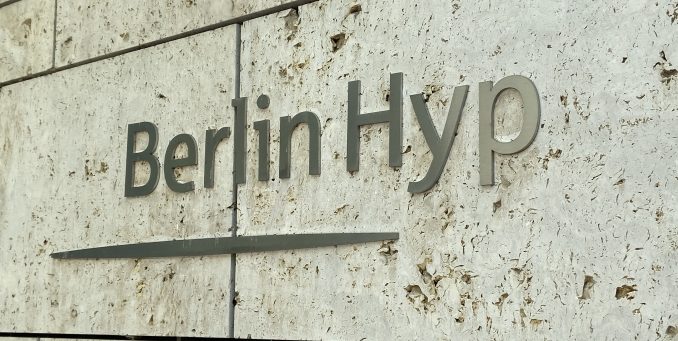
Berlin Hyp became the first bank to sell a sustainability-linked bond (SLB) yesterday (Tuesday), issuing a €500m 10 year senior preferred bond with a coupon step-up should it not hit a carbon reduction target, in a “courageous” move that met with dedicated investor interest and achieved tight pricing.
The order book for the SLB peaked at close to €1bn, with 73 investors in the final order book, allowing for pricing of 35bp over mid-swaps – the tightest level on a 10 year senior preferred benchmark since a Nordea trade in 2017.
Berlin Hyp’s deal offers investors a coupon step-up of 25bp in the final payment should the issuer not achieve a sustainability performance target (SPT) of a 40% reduction in the carbon intensity of assets refinanced in its loan portfolio between 2020 and 2030. This in line with the bank’s overall sustainability strategy released in August 2020 and Germany’s goal for its real estate sector to meet its Paris Agreement commitment, and second party opinion provider Sustainalytics deemed the SPT “ambitious” and demonstrating industry leadership.
See previous coverage for more details.
“The amazing outcome shows that the market is open for innovative structures,” Bodo Winkler-Viti, head of funding and investor relations at Berlin Hyp, told Sustainabonds. “We have been able to issue a beautiful tightly-priced SLB and are absolutely grateful for the result.
“The market clearly honours ESG targets and our approach to sustainability.”
The new SLB broadens the market for such instruments into the financial institutions space, following its inception in September 2019 by Italian corporate ENEL and a boom after the release of Sustainability-Linked Bond Principles in June 2020.
“Having Berlin Hyp out in this format should pave the way for future issuance with similar structures, and continue to drive ingenuity further in this sector, to accommodate both issuer and investor needs,” said George Kalbin, director, FI syndicate, at SLB structuring advisor Crédit Agricole.
Leads Crédit Agricole, Commerzbank, DZ, HSBC and LBBW launched the SLB yesterday morning following a mandate announcement on Friday and investors calls on Monday.
Following initial price thoughts of the mid-swaps plus 50bp area, the leads reported books above €800m, including €135m joint lead manager interest, after around two hours and 40 minutes. An hour later, they revised guidance to plus 35bp-40bp, will price in range, on the back of around €985m of demand, and set the size at €500m, with around €790m of orders ultimately good at re-offer.
“Berlin Hyp’s ground-breaking trade was based on a strong order book built on granular high quality orders with a large share of real money investors,” said Marc Just, head of FIG and SSA origination at LBBW. “It achieved highly competitive pricing, offering no new issue concession compared to its peers – no other 10 year senior preferred bond has priced lower in the last three years.”
With the issuer’s outstanding paper illiquid and tight in the secondary market, the leads referenced the levels of other double-A names to put fair value for the new issue in the low to mid 30s over mid-swaps, with the pricing effectively flat to fair value a better outcome than that achieved on any recent unsecured FIG trade. The pricing at plus 35bp also made the new issue Berlin Hyp’s tightest 10 year senior preferred trade.
A syndicate banker away from the leads said that although the book “didn’t overwhelm”, the final spread was a “strong outcome”.
“The value of green is higher in a bull market,” he added, “with investors jumping into these trades because they know they will tighten quickly and stay tighter in any volatility. In a stable or sideways market like we have now, it is easier for them to pass.”
Winkler-Viti (pictured) acknowledged that the book was not the biggest the issuer has ever achieved, but said the ESG linkage helped the result.
 “A significant number of the investors that we met for one on one meetings in our virtual roadshow are dedicated to ESG, with their analysts asking a lot of questions,” he added, “and we ultimately encountered them in the order book, which is something of an endorsement of the project.”
“A significant number of the investors that we met for one on one meetings in our virtual roadshow are dedicated to ESG, with their analysts asking a lot of questions,” he added, “and we ultimately encountered them in the order book, which is something of an endorsement of the project.”
The final book comprised 73 accounts from 13 countries, with fund allocated 55.1%, banks and other financial institutions 32.1%, official institutions and agencies 10.8%, and insurance companies and pension funds 2.0%. Domestic German investors took 70.7%, Asia 10.0%, the UK and Ireland 4.0%, France 3.8%, Italy 3.5%, Nordics 2.9%, Austria 1.7%, Spain 1.5%, Benelux 1.1%, and Switzerland 0.8%.
Winkler-Viti said several investors, particularly smaller domestic accounts, were interested in the SLB unable to participate in the first issue because the potential step-up coupon necessitated new product approval.
“But hopefully this is not our last SLB and we can reach them when we return,” he said.
Issuing the first SLB from a bank builds on Berlin Hyp’s achievements of issuing the first green covered bond in 2015, which was also the benchmark green bond from a European bank, and being the European bank to have issued the most benchmark green bonds.
“Back in 2015, I was already quite sure others would follow and that the market would be unstoppable,” said Winkler-Viti. “If you look now at how issuance volumes have risen exponentially in the past few years, it is indeed unstoppable.
“Now, SLBs are the new kid on the block, playing a slightly different role than the three existing instruments, because they are the first without the use of proceeds approach. I believe they can play a very big role.”
Despite the success of the first bank SLB, some market participants are unsure of the extent to which others will follow.
“Not long ago I would have said there will be no bank SLBs,” said one. “But Berlin Hyp is a specialised lender with a homogenous loan book and the SLB is like a look-through to the real estate. Plus Berlin Hyp is so green that they must all be vegans.
“It was a courageous move.”
An obstacle cited by many market participants is that the treatment of SLBs for MREL purposes is unclear – although this was not an issue for Berlin Hyp since, with an MREL ratio of 57%, its senior preferred debt is not MREL-eligible.
Suvi Platerink Kosonen, senior sector strategist, financials, at ING, for example, noted that MREL eligibility requires that interest may not be amended based on the credit standing of an entity, and that debt instruments with embedded derivatives be excluded from eligible liabilities with only call optionality and variable interest derived from a broadly used reference rate allowed – both of which could raise concerns in relation to SLBs.
“Berlin Hyp has brushed off these concerns by indicating its SLB is not even intended to be MREL eligible,” he added. “The jury is still out for other bank issuers.”
China Construction Bank is set to issue the second bank SLB as it is planning to include one in a multi-tranche, multi-currency transaction announced yesterday that will also include green bond and transition bond tranches issued out of group entities.



